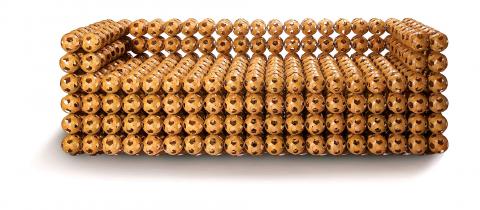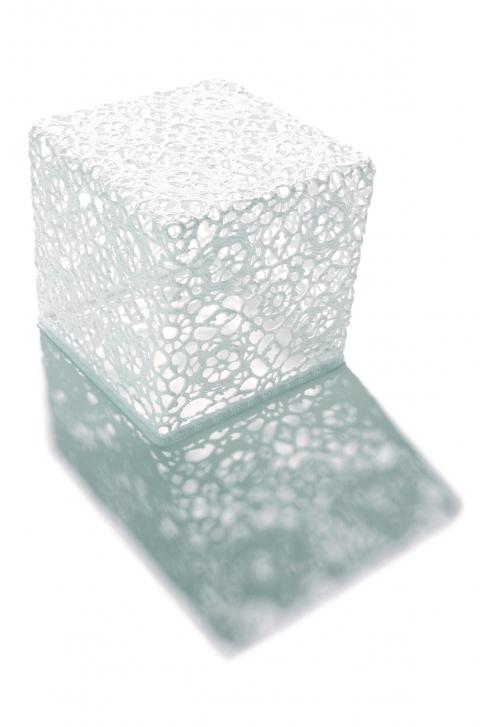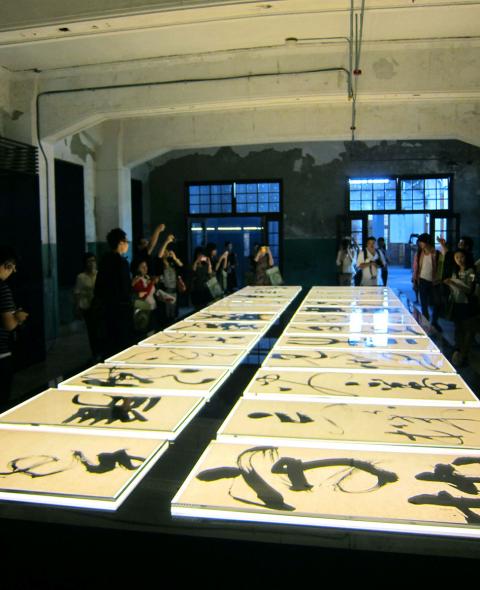The Taiwanese government is wagering that two upcoming events will help establish this country’s international design reputation.
Taipei was chosen after competing with 19 cities as the location for the first International Design Alliance Congress, a biennial event that takes place from Oct. 24 to Oct. 26 and will bring together design and non-design industries. The Taipei World Design Expo (台北世界設計大會) was organized separately by the Taipei City Government and the Taiwan Design Center (台灣創意設計中心) as a “parallel event” to the IDA Congress. The expo starts tomorrow at Songshan Cultural and Creative Park (松山文創園區) and includes exhibits at Taipei World Trade Center Nangang Exhibition Hall (台北世界貿易中心南港展覽館) and the Taipei World Trade Center (台北世界貿易中心).
Promotional materials for the expo, which comprises 6,000 items by 1,200 designers, tout it as part of a “year of design” that marks the Republic of China’s centennial and celebrates “the ingenuity and style of Taiwan designers” — but there is also a pragmatic reason behind the monthlong event.

Photo Courtesy of the Taiwan Design Center
It is part of the Ministry of Economic Affair’s efforts to increase the profile of Taiwan’s creative industries in response to the steady decline of original equipment manufacturing jobs since the 1990s because of competition from factories in China and Southeast Asia. The government also hopes that raising the profile of local designers will help increase the country’s soft power, says Tony Chang (張光民), chief executive officer of the ministry-backed Taiwan Design Center, which was set up to promote the local design industry.
“There is a lot of young talent here and I think that Taipei has the potential to be a world design center,” says Chang.
The Taiwan Design Center began working with the ministry and the Taipei City Government one year ago to apply for the IDA Congress, which will feature a roster of workshops and high-profile keynote speakers including Quanta Computer Inc (廣達電腦) chairman Barry Lam (林百里) and Esko Aho, former prime minister of Finland and currently Nokia’s head of corporate relations and responsibility.

Photo Courtesy of the Taiwan Design Center
IDA Congress organizers Mark Breitenberg, Russell Kennedy and Shashi Caan told the Taipei Times in a joint statement that Taipei was chosen for the event in part because “of the level of engagement and support from all levels of government.”
Taiwan is “recognized internationally for its drive to differentiate itself through design and design-led innovation,” the organizers said.
The Taipei City Government sees the congress as the latest in a series of large-scale events, including 2009’s Deaflympics and last year’s Taipei International Flora Exposition, that it hopes will establish Taipei as a desirable host city. Chang estimates one million people will visit the Taipei World Design Expo over the next month, with 100,000 visitors coming from abroad.

Photo: Catherine Shu, Taipei Times
Other measures that the government has taken in a bid to increase the nation’s soft power include the far-reaching Cultural and Creative Industries Development Act (文化創意產業發展法), which was passed in January last year and provides tax incentives for companies to purchase products or services designed and manufactured in Taiwan.
Chang cites the increasingly strong performance of local designers in international competitions as proof that the Taiwanese government’s initiatives, which include sponsoring trips to high-profile events like Milan Design Week, are working. According to records kept by the Taipei City Department of Culture, Taiwanese designers last year won a total of 260 awards at Germany’s iF Product Design Awards and Red Dot Design Awards, the US’ International Design Excellence Awards (IDEA) and Japan’s Good Design Awards. In 2003, designers won just a total of 16 awards (five at iF and 11 at Good Design).
“Taiwan is in the midst of a metamorphosis. ‘Made in Taiwan’ products became widely available in the global marketplace in past decades, signifying Taiwan’s status as a prosperous manufacturer. But today’s Taiwan is striving for design leadership,” said International Council of Societies of Industrial Design president Breitenberg in an e-mail interview.

Photo: Catherine Shu, Taipei Times
But curator Sean Hu (胡朝聖), who organized themed exhibits on sustainable and industrial design at Songshan Cultural and Creative Park, says many Taiwanese designers still struggle.
“When a lot of people think of Taiwan, they still think of original equipment manufacturing and other industries like that. They are not familiar with Taiwanese designers,” says Hu.
Hu says that Taiwan’s investment in the design industry has begun to pay off, but designers here face the economic challenges of working within a small marketplace. He adds that the government should focus on helping companies expand internationally while increasing local consumer awareness of products designed in Taiwan.
Taiwan’s global design reputation “is something that grows gradually, step-by-step,” says Hu. “I think one of the main points of an event like this is also to expose Taiwanese people to the capabilities of Taiwanese design. I think it is important to show how design can increase the quality of life for everyone.”
TAIPEI WORLD DESIGN EXPO
The Taipei World Design Expo, which runs until Oct. 30, takes place at three locations: It will start at Songshan Cultural and Creative Park tomorrow and additional exhibits will open Oct. 22 at the Taipei World Trade Center Nangang Exhibition Hall and Taipei World Trade Center Exhibition Hall 1. The Museum of Contemporary Art (MOCA, 台北當代藝術館), Taipei Fine Arts Museum (TFAM, 台北市立美術館) and Xue Xue Institute (學學文創志業) will host related activities.
Tony Chang says that one of the Expo’s key words is “beneficence.” Themed exhibits at the three locations focus on a wide variety of topics, ranging from graphic design and traditional Chinese calligraphy to industrial design and architecture.
“One of the goals of design is to make people’s lives more comfortable and fulfilling. We wanted to emphasize that,” says Chang.
A professor at National Taiwan University of Arts (國立臺灣藝術大學), Sean Hu chose sustainable design as the theme for one of his exhibits, titled In Bliss (幸福所在), at Songshan Cultural and Creative Park. Items include a lampshade molded from sea salt, furniture built from recycled wood and prototypes of products that can be made by fair-trade workshops.
“The point of the exhibit is not to show off how great these designs are,” says Hu. “It is to pinpoint the challenges facing our environment and how designers can respond to them.”
The Taiwan Design Center is in the process of moving its offices from Nangang to Songshan Cultural and Creative Park, and the Taiwan Design Museum (台灣設計館) recently opened at the location. Chang envisions the space as a “gathering place and headquarters for Taiwan’s design industry.”
He adds that the Taipei City Government used Shanghai’s approach to the arts and design as a model when it turned industrial spaces — including Songshan Tobacco Factory (松山菸廠) and Huashan 1914 Creative Park (華山1914), a former winery — into cultural centers. In Shanghai, art exhibits at repurposed structures like 50 Moganshan (莫干山50號) and 1933 have helped establish the city as a cultural capital.
“Design has to have meaning. It has to be connected with a place’s history and its people,” says Chang.
The Taipei World Design Expo starts tomorrow at Songshan Cultural and Creative Park, 133 Guangfu S Rd, Taipei City (台北市光復南路133號) and runs until Oct. 30. The exhibitions at Nangang Exhibition Hall and the Taipei World Trade Center start on Oct. 22 and also run until Oct. 30. Entry is free. For more information, visit www.2011designexpo.com.tw.
IDA CONGRESS
The theme of the first IDA Congress is “design at the edges,” and the three-day event aims to facilitate a dialogue between designers and members of non-design industries. The composium will bring together 176 speakers from 25 countries, including government representatives, scientists, researchers, NGO members and students. It is co-organized by the International Design Alliance, which consists of representatives from the International Council of Societies of Industrial Design (ICSID), the International Council of Graphic Design Associations (Icograda) and the International Federation of Interior Architects/Designers (IFI).
The goal of the biennial event is “to meet the realities of the new global economy, where all design disciplines are collaborating with global leaders on key social, cultural and economic development issues,” organizers said in a statement to the Taipei Times.
“The IDA is opening the conversation up to include everyone with an interest in design — not only as delegates or visitors to the exhibits, but as participants in sessions and panel discussions. We want to encourage relationships in fields where the contribution of, and connection to, design is less obvious.”
In addition to Quanta chairman Barry Lam and former Finnish prime minister Esko Aho, the international roster of keynote speakers includes environmental activist Vandana Shiva; Peter Bishop, the deputy chief executive of the London Development Agency; and Bob Elton, a member of the World Economic Forum Global Agenda Council on the Skills Gap. There will also be salons and workshops, several of which are geared toward young designers and students.
Registration for the three-day event is NT$21,700 for general admission and NT$6,500 for students. For more information, visit www.2011idacongress.com.

In the March 9 edition of the Taipei Times a piece by Ninon Godefroy ran with the headine “The quiet, gentle rhythm of Taiwan.” It started with the line “Taiwan is a small, humble place. There is no Eiffel Tower, no pyramids — no singular attraction that draws the world’s attention.” I laughed out loud at that. This was out of no disrespect for the author or the piece, which made some interesting analogies and good points about how both Din Tai Fung’s and Taiwan Semiconductor Manufacturing Co’s (TSMC, 台積電) meticulous attention to detail and quality are not quite up to

April 21 to April 27 Hsieh Er’s (謝娥) political fortunes were rising fast after she got out of jail and joined the Chinese Nationalist Party (KMT) in December 1945. Not only did she hold key positions in various committees, she was elected the only woman on the Taipei City Council and headed to Nanjing in 1946 as the sole Taiwanese female representative to the National Constituent Assembly. With the support of first lady Soong May-ling (宋美齡), she started the Taipei Women’s Association and Taiwan Provincial Women’s Association, where she

Chinese Nationalist Party (KMT) Chairman Eric Chu (朱立倫) hatched a bold plan to charge forward and seize the initiative when he held a protest in front of the Taipei City Prosecutors’ Office. Though risky, because illegal, its success would help tackle at least six problems facing both himself and the KMT. What he did not see coming was Taipei Mayor Chiang Wan-an (將萬安) tripping him up out of the gate. In spite of Chu being the most consequential and successful KMT chairman since the early 2010s — arguably saving the party from financial ruin and restoring its electoral viability —

It is one of the more remarkable facts of Taiwan history that it was never occupied or claimed by any of the numerous kingdoms of southern China — Han or otherwise — that lay just across the water from it. None of their brilliant ministers ever discovered that Taiwan was a “core interest” of the state whose annexation was “inevitable.” As Paul Kua notes in an excellent monograph laying out how the Portuguese gave Taiwan the name “Formosa,” the first Europeans to express an interest in occupying Taiwan were the Spanish. Tonio Andrade in his seminal work, How Taiwan Became Chinese,